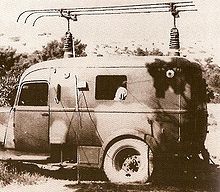- Near Vertical Incidence Skywave
-
Near Vertical Incidence Skywave, or NVIS, is a radio-wave propagation method that provides usable signals in the range between groundwave and skywave distances (usually 30 to 400 miles, or 50 to 650 km). It is used mainly for military and paramilitary communications and by radio amateurs. The radio waves travel upwards into the ionosphere, where they are refracted back down and can be received within a circular region up to 650 km from the transmitter. If the frequency is too high, refraction fails to occur and if it is too low absorption reduces the signal strength.
The usable frequencies for NVIS communications are between 1.8 MHz and 15 MHz. The most common bands used in amateur radio are 3.5 MHz and 7 MHz, with experimental use of 5 MHz (60 meters) frequencies. Military NVIS communications mostly take place on 2-4 MHz at night and on 5-7 MHz during daylight. The lowest layer of the ionosphere, called the D layer, causes attenuation of low frequencies during the day. This layer disappears at night enabling improved communications at the lower frequencies during this time
An NVIS antenna configuration is a horizontally polarized (parallel with the surface of the earth) radiating element that is from 1/20th wavelength (λ) to 1/8 wavelength above the ground. That proximity to the ground forces the majority of the radiation to go straight up. Overall efficiency of the antenna can be increased by placing a ground wire slightly longer than the antenna parallel to and directly underneath the antenna. While the ground wire is not necessary under good to excellent propagation conditions, antenna gain in the 3 dB to 6 dB range are common when the ground wire is used.
Significant increases in communication will be realized when both the transmitting station and the receiving station use NVIS configuration for their antennas.
NVIS is most useful in mountainous areas where line-of-sight propagation at VHF or UHF frequencies is ineffective or when the communication distance is beyond ground wave (more than 50 miles, 80 km) and less than sky-wave (300 to 1500 miles, 500 to 2500 km).
See also
References
- Antony Wedgwood, G0TJD; Goldstein, J. A. (April 2001). "Near Vertical Incidence Skywave". The Vintage and Military Amateur Radio Society Newsletter 16: 7–11. Bibcode 1995nrl..reptS....W.
- Hawker, Pat (1999). Technical Topics Scrapbook 1990-1994. Potters bar,UK: Radio Society of Great Britain. pp. 33–34, 64–65. ISBN 1-872309-51-8.
- Hawker, Pat (2005). Technical Topics Scrapbook 2000-2004. Potters bar,UK: Radio Society of Great Britain. pp. 61, 89–90,109–110, 126, 143, 154. ISBN 190508605-9.
- Walden, M. (March 2008). "Extraordinary Wave NVIS Propagation at 5 MHz". RadCom (RSGB) 84 (03): 57–62.
External links
Categories:- Radio frequency antenna types
- Radio frequency propagation
Wikimedia Foundation. 2010.

